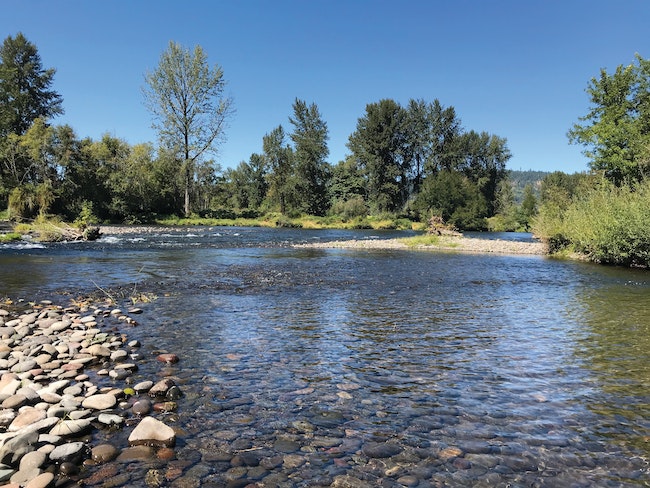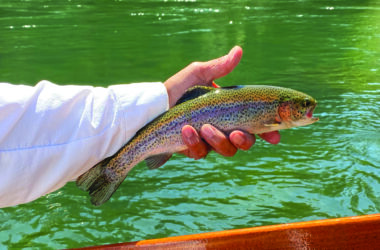 FRANK ARMENDARIZ/PHOTO
FRANK ARMENDARIZ/PHOTO
At low water levels, portions of the McKenzie River’s main channel can become difficult to read. If possible, stop and scout – but always wear a life jacket in or out of the boat while on the river.
Cooler weather was in the forecast as I prepared this week’s report, which is always good for summer fishing. But the record-high temperatures that climate scientists are attributing to our changing world have already extracted quite a toll on many outdoors resources, particularly our inland fisheries and our tender-dry forests. As expected, last week the Oregon Department of Fish and Wildlife set in place “Hoot-Owl” regulations that limit fishing hours from one hour before sunrise to 2 p.m. A full list of waterways affected are on the ODFW website myodfw.com.
Our region encompasses two individual ODFW angling zones: The Willamette River, from the falls at Oregon City to the mouth of the McKenzie River, is the only river that Hoot-Owl regulations apply to in the southern part of the Willamette zone. The southern portion of the Northwest Angling Zone around Florence is also free of Hoot-Owl restrictions.
For our immediate region the ODFW only asks that you land any fish you plan to release quickly and that your gear is sized correctly to enable that quick release on all inland waterways.
For a couple of weeks the Army Corp of Engineers who manage all the flood control reservoirs in the valley created a period of artificial high water in the Willamette River drainage. Prior to that valley river flows had been dropping and warming so fast, that thousands of salmon were essentially trapped below the falls at Oregon City. Most of the water released came from Blue River Reservoir at a rate of about 1,400cfs and prompted concerns from lake users that the lake was being drained.
It also knocked down the trout fishing on the McKenzie during the release, raising the ire of river guides struggling to recover a piece of last season’s COVID-19 losses. But the water release pulled thousands of chinook salmon up river. By no means is this year’s salmon run all that great; as of the end of June, only 26,000 of a projected 36,000 had passed over the falls headed to the Willamette River tributaries. But the water release appears to have averted what could have been a real catastrophe.
***
On the arrival of fresh hatchery salmon, fishing for them ticked up and will likely hold for the next week or two. The temporary high water also encouraged good numbers of wild chinook up river, to their birth place and genetic stronghold on the McKenzie River, ensuring that their enduring genetics, like they have for thousands of years, will be passed to a new generation of McKenzie River salmon.
Unfortunately the artificial high water event did little to help Willamette Basin’s steelhead run, which remains one of the lowest in the history of this entirely hatchery-produced fishery.
Trout fishing on the McKenzie continues to be good, though most productive early and late in the day. Currently running at 1.15 ft. at the Vida river gage, the McKenzie above Leaburg Dam becomes much more technical at that level. So if you venture above Leaburg, wear your life jacket and prepare to have your intermediate drift boat skills tested. Another thing about fishing on the McKenzie above Leaburg dam: The recovery and rebuilding effort in the aftermath of the Holiday Farm Fire is ongoing and in these summer months at a quickened pace. So if you drive up the McKenzie River Highway, expect “delays” … a lot of them.
Please be patient and budget your time, especially Monday-Friday. Also within the recovery zone, only Ben and Kay Dorris County Park and boat landing remains closed. Unless you have the skills to run Marten Rapids on a float from Blue River or Finn Rock, your best and last chance to take out is at Silver Creek landing and only in an emergency should you consider Rennie Falls landing.
At low water the ramp Rennie has a very sharp two-foot dropoff, is extremely difficult to negotiate and can be somewhat dangerous to use.
Back bouncing salmon eggs or sand shrimp have been the most productive baits for salmon. In the late afternoon, fly fishing on the McKenzie can be spectacular and a “slow-rolled” spinner or a drifted salmon egg or worm chunk can be deadly effective even in mid-day for the copious amounts of hatchery trout that have now been planted in the river from Blue River down to Hendricks Wayside.
I have never mentioned walleye in my report … until today. I heard the rumors for years – even saw some photos of walleye caught in the Middle Willamette River below Dexter Dam – while salmon fishing. But the invasive sunny fish looks to have now established itself in the upper Middle Willamette basin reservoirs. The fact that the fish is invasive is concerning but walleye are delicious to eat and personally I look forward to seeing if I can put a dent in their numbers very soon.
***
Far western Lane County is exceptionally dry. We have escaped the blazing temperatures but the 30-degree temperature differential between the valley and coast has caused strong coastal winds to develop in the afternoon – up to 25 mph and higher gusts.
 FRANK ARMENDARIZ/PHOTO
FRANK ARMENDARIZ/PHOTO
Holly Lathrop of Portland with a largemouth bass from one of the Florence dune lakes. This took a soft plastic salamander bait, rigged Carolina style. With water temperatures in the low 70s the dune lakes are at full stride.
Getting an early start is important but you should be able to get several hours of what has been very good fishing. Predictably the wind has been kicking up about 2 p.m. each day, but with a cool down in the valley I expect the wind to settle for a few days.
Conditions allowing salmon fishing out of the Port of Siuslaw have been fair with trips averaging about a fish and a half per angler. The crabbing has been “fair to good” too, from the public crabbing dock on the south jetty and for those able to drop a pot from a boat in the lower Siuslaw Bay.
On the dune lakes the wind has also been an issue in the afternoon but the morning bite for largemouth bass has been good since May and continues to produce good days of fishing. The lakes out west are also lower than normal. Some average only about 15 feet in a wet year, this year you need to keep one eye on your depth finder and the other for emerging stumps and fallen trees. The south end of Siltcoos can be very windy, and white caps can quickly pop up. But Mercer, Sutton and Munsel are better wind-protected bodies, have bass and trout, and are a good choice for small boats and fishing kayaks.
Email:








